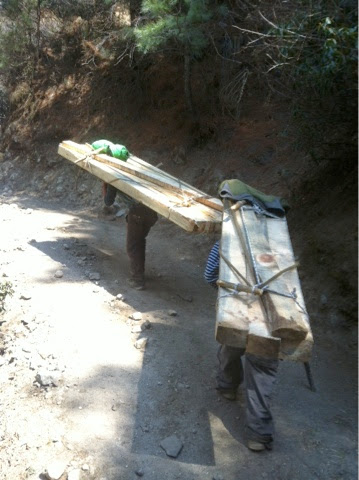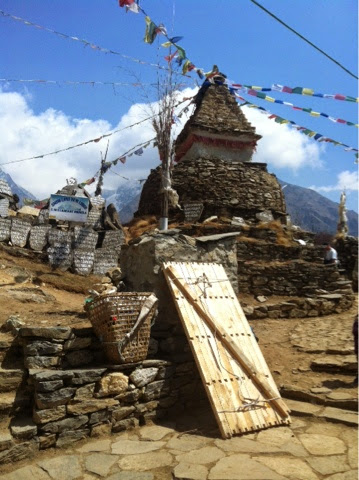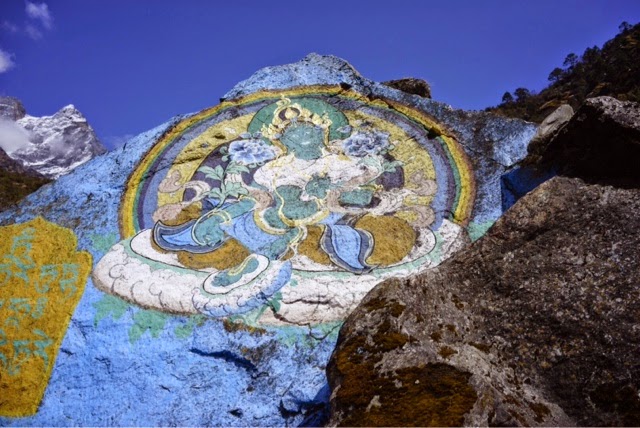Category : Uncategorized
Looking forward to using these on Everest
complete with fixing mount for the super light Sony a7R I’ll have with me
and a Canon 5d MkIII
and a Gitzo tripod
and some Bushman Panoramic heads

and a prototype Rab down suit
and some Mountain Fuel
and an M60 Sunload solar charging kit
and some EDZ touchscreen smartphone gloves
Now then …. where did I put my extra large kitbag?
| When you know your gear you also know immediately when you have done something incorrect – it just feels different. |
For more information about what skills are required then have a look at this page of suggestions as well as some notes on how to use jumars on fixed ropes
 |
| It will have been much more tricky for this guy to put his crampons on the wrong feet than to put them on the right feet. |
 |
| On a slope where you want to have perfect footwork and you need your technique to be just so it can all end up going drastically wrong when a crampon pops off because of a compatibility issue. |
A very good editorial piece in The Times today. Hadn’t read it when I sent my last Blog update an hour or so ago but I’ll quote the bit that I think sums it all up:
‘To make it safer, Nepalese authorities are considering installing fixed ladders up the Step for the climbing season. Their motives are laudable but their solution is wrong.
‘Every year Sherpas already fix safety ropes all the way up the Step, mainly for the use of high paying clients of commercial expeditions. These make it technically straightforward even for inexperienced climbers. What no amount of extra equipment bolted to the rock can do is turn amateur adventurers who spend most of the year in an office into elite mountaineers. Ladders might, in fact, fool more people into thinking Everest is no more than an arduous hike.
‘The chance of climbing Everest is open to anyone, and the local economy depends on those who pay to compensate for lack of experience or fitness. The way to keep the death toll in the “death zone” down is not to pretend the climb is easy. It is to remind people that it is hard.’
I couldn’t have put it better and more succinctly myself.
In the last few days there has been furious debate on the news and in social media circles about whether ladders will be installed on the Hillary Step as if this is going to be a solution to the congestion that can occur on summit day. When there are only a few folk around on summit night it won’t make much difference, but when there are a reasonable number of folk it could actually make the situation worse.
There are a number of problems about getting ladders to the Hillary Step in the first place and this will be a particularly hazardous venture. How on earth can the expedition companies and wannabe summiteers possibly justify putting the lives of Climbing Sherpas at risk just to potentially shave a few minutes off the time it takes to negotiate the Hillary Step? And once they are there there will be an assumption of safety – a bit like assuming that all bolts are safe when rock climbing – which may compromise people who aren’t judicious in their assessment of the situation. And then there is the danger of getting hung up on a ladder whether that be a person slipping and ending upside down with their leg jammed between a rung and the rock or catching clothing or equipment on a part of the ladder and not being able to extricate themselves accordingly.
You don’t need to be a climber to climb Everest – but personally I am a firm advocate of the fact that if you are coming to Everest from a climbing and mountaineering background then you will be better placed to be able to cope with the ever changing conditions on the hill. Not only your ability to react to the changes throughout the day, or the changes in the weather, but also the ability to react to the ever changing terrain – which includes your ability to safely negotiate through the Khumbu Icefall, tackle steep icy slopes on The Lhotse Face and scramble or climb up and over The Yellow Band, The Geneva Spur and The Hillary Step.
I am not saying that non climbers need not apply … but that non climbers ought to at least take some form of responsibility for themselves and get suitably well versed prior to the trip. See the list of skills I recommend aspirants should have.
As ever I will bore you with my analogy that if someone was going to do The London Marathon they would undoubtedly get off the sofa and on to the roads and down to the gym. After a reasonable amount of training they would probably sign up for the odd half marathon and then up the training schedule towards the time of the event. Equally you would’t expect to be able to free fall from a plane or do a 45m Scuba dive without first having done some training and possibly some courses to gain certification. So why do people expect that they can just attempt Everest? And when they do attempt it and either fail miserably or die in the process why is everyone up in arms and surprised about it? Sadly there are people who die every year during marathons around the world but people aren’t shouting from the roof tops that marathons should be banned or regulated or that the cost should be increased.
There will always be the programmes on the telly about the inexperienced chap or chappesse who climbed Everest, and this will always attract the occassional non-climbing-mid-life-crisis-armchair-mountaineer … but what they don’t realise is that perhaps the person on the programme was naturally predisposed to being good at altitude, maybe they had actually done a bit of training and the programme wasn’t fully honest, maybe they had a very good team of Climbing Sherpas, lots of oxygen and brilliant weather conditions. And maybe they were just plain lucky.
The wannabe Everest summiteer then signs up with a cheap crappy company who don’t have a good handle on logistics, don’t have very good Climbing Sherpas, don’t have enough (or even any) oxygen, don’t have a strict 1:1 summit day client / Sherpa ratio, don’t have weather forecasting, don’t mentor their clients during the trek in, don’t have high altitude medication issued to everyone AND know how to use it, don’t train their clients in oxygen protocols etc etc. And then that person, who is already a liability to themselves, becomes a liability to everyone around them.
Am I going to feel a duty of care to that person or am I going to try and make sure that my clients are nowhere near them and are not being endangered as a consequence? The latter for sure.
 |
| The 2nd step. A slightly bigger cliff than the Hillary Step.
© Stuart Holmes www.lakespanorama.co.uk
|
So back to the thorny issue of ladders on The Hillary Step. Yes there is a ladder on The Second Step on the North side of Everest but this is a slightly different proposition and it would not be correct to try and compare like for like. The Second Step is a much steeper and much more difficult piece of terrain and without the ladder there would be a huge risk of people succumbing to exhaustion trying to ascend this rocky corner. The Hillary Step is a much smaller rocky outcrop and can be negotiated in a matter of minutes by well versed climbers. A ladder, or ladders, may well give people a false sense of security and encourage more climbers to try and attempt the summit on the same window.
This is akin to there being a good weather forecast on a Bank Holiday Monday, a couple of crappy days and then an equally great forecast on the Thursday of the same week. If you can take a day off work mid week when are you going to travel from London to Brighton? Sure, if you go on the Monday you could start early to avoid the queues but undoubtedly at some stage of the day it will be busy on the roads, busy in the car parks, busy in the shops, on the beach and in the pubs and cafes. So surely going on the Thursday when it is quiet would be a better solution? Avoid the queues rather than add to the queues.
Challenge by choice comes in to effect and this should, to a certain extent, equally apply to Everest.
Well it’s that time of year again when it all gets very hectic prior to my departure for my next expedition on Everest.
The final few weeks prior to departure are always crammed with lots of e mails from clients my who are themselves trying to organise their lives in preparation for their departure. Then there’s shopping for supplies, packing, sending freight, updating the agent in Kathmandu for them to make the permit application, updating my Sirdar with our requirements for Base Camp and logistics on the hill as well as taking bookings for the next Ama Dablam expedition, packing my stuff ready for my departure and making sure that the Bed and Breakfast is going to run smoothly in my absence.
And of course there is the all important issue of spending time with my family. I used to be ‘away’ for about a fortnight before I actually went away. But thankfully now that I am pretty well versed in the whole pre expedition build up I am able to be here right until the last minute which I think the children appreciate (probably more than they realise).
Despite losing our illustrious B&B housekeeper of 3 years we have managed to find a replacement who is rising to the challenge. So ‘tarra’ to Suzanna and ‘Olá’ to Juan. Juan will be taking the helm full time 7 days a week for the whole of April and May (and then staying with us until at least September) and is obviously going to do a great job … but there is so much to hand over that it would be easy to overwhelm him with the task at hand. Yes there are breakfasts to cook, guests to meet and greet and rooms to clean but there are also all the other sundry naunces that he needs to be well versed in. Where to go for supplies, how to update availability, what information is required to take a booking, how much deposit is required to confirm a booking, where the receipts go, where are the spare lightbulbs, the stop cock, the electrics box and the fire alarm panel? When does the laundry go out, where do we keep the cleaning supplies and the spare top ups for the tea trays? Who do we order from when we are running low on x, y and z? Where do we keep the spare rolls for the pdq machine, what is our cancellation policy and what’s the WiFi password? Etc etc etc.
It’s only when you’re handing over the reins that you start to realise just how many different facets there are to running your own small business. It’s all very well telling Juan that he can ask my wife – but she is going to be up to her eyeballs with work, getting the children to and from school, answering e mails on my behalf, keeping the family entertained at the weekends and coping with the usual mundanity of shopping for food, making sure the car has an MOT etc etc.
But despite all that, I can thankfully depart next Thursday knowing that the B&B is in very good hands.
I’ll be arriving in Kathmandu a few days ahead of my group and a hectic few days always ensues where I have to go to The Ministry of Tourism, meet the agent, meet my Sirdar, go shopping for our Base Camp goodies, stock up the extensive first aid kit, split the gear down in to what is going straight to Base Camp and what will be accompanying us for the trek in etc etc. Then once we are all convened in Kathmandu we fly to Lukla and start trekking.
I use the trek in as an opportunity to train and mentor my clients so that we arrive at Everest Base Camp fit, acclimatised and switched on. Unlike most teams who sprint in to Base Camp in 8 or 9 days (and then wonder how they will climb THAT when they feel like THIS down here at Base Camp) we will be spending 3 weeks trekking in which gives my group a chance to unwind, clear their last minute in tray and start to comprehend the enormity of what lies ahead. We get off the beaten track, visit some amazing people and cross some high passes which means that we get to Everest Base Camp in really good order. We can then go from fun trekking mode to fun, but serious, expedition mode and start the rotations lower on the hill (up to around 7,100m).
The sessions I cover whilst we are trekking in range from avoiding frostbite and hypothermia to oxygen protocols and high altitude medical issues. We discuss the importance of concurrent activity and go through safe travel techniques. We will also cover issues such as avoiding other climbers who look like they are a liability to themselves (and therefore everyone around them), and the benefit of working as a team rather than a bunch of individuals.
I also discuss the rather sobering topic of death on the hill. Not so much death within our group, but the fact that other people from other teams may pass away during the expedition period for a whole variety of reasons – some of which, tragically, are avoidable. There are obviously objective hazards, such as a lump of ice or a rock bopping someone on the head, but there are the other aspects that people don’t fully comprehend. I have written elsewhere about the fact that some teams don’t provide a full range of inclusions or that there is small print that means that sometimes clients who thought they were getting a fully inclusive experience suddenly find themselves at The South Col without a Climbing Sherpa and not enough oxygen. These are the unfortunate people who may succumb to extreme hypoxia or be completely overwhelmed by exhaustion.
Whilst we do discuss these issues there can’t be any hard and fast rules about dealing with ill, dying or dead climbers because there are too many factors and different scenarios to comprehend. Obviously the primary concern has got to be the safety of my group and after that we then have to start deciding whether our efforts will endanger or jeopardise ourselves, whether there is help on the way, who the person is with and what is being done about their situation etc etc? Do we start injecting people with dexamethasone if that will then deplete our supply and jeopardise our health and well being? It is obviously an unsavoury subject but I firmly believe that it makes us mentally stronger and certainly safer if the people in my team realise just how vulnerable we all are up there. To that end my team are less likely to lie to me about how they are feeling during the trip (and therefore hide or mask symptoms I could otherwise be dealing with) and certainly less inclined to suffer from summit fever. Just because someone doesn’t feel great one day doesn’t mean that the expedition is over for that individual – but if they don’t tell me how they are feeling then what may well be a benign condition (that I can help them with) could otherwise deteriorate in to a life threatening situation.
A bit like all the information I am handing over to Juan in the B&B there are many, many aspects of ultra high altitude that need to be imparted to the group so that they can safely attempt to negotiate this HUGE mountain.
There are undoubtedly many self imposed pressures that my group will be feeling – especially in this day and age of social networking when everyone knows about each others intentions. Then there will be the unnecessary distractions that they will have ranging from a flat battery meaning that their camera isn’t working one day to not being able to get 3g working on their phone the next. Does it really matter? Well, yes, it does, but let’s not let it be a distraction.
So whilst all their distractions are valid to them at that time they will need to sift out what is, and what isn’t, important and deal with it appropriately.
Basically they will need to learn not to sweat about the small stuff.
And on the note of cameras … I have been loaned a Canon 5d mkIII and a Sony a7R along with tripod, various attachments for making panoramic photos, solar charging, a range of batteries and cables and LOADS of memory . Thomas from http://www.mountainpanoramas.com/ came across at the weekend and gave me a tutorial about what is required, how to use the equipment and common pitfalls (like not removing the lens cap!). We had a practice yesterday and he has stitched the result together and, all told, I’m fairly happy with what has been my first effort (click for a higher resolution image).














